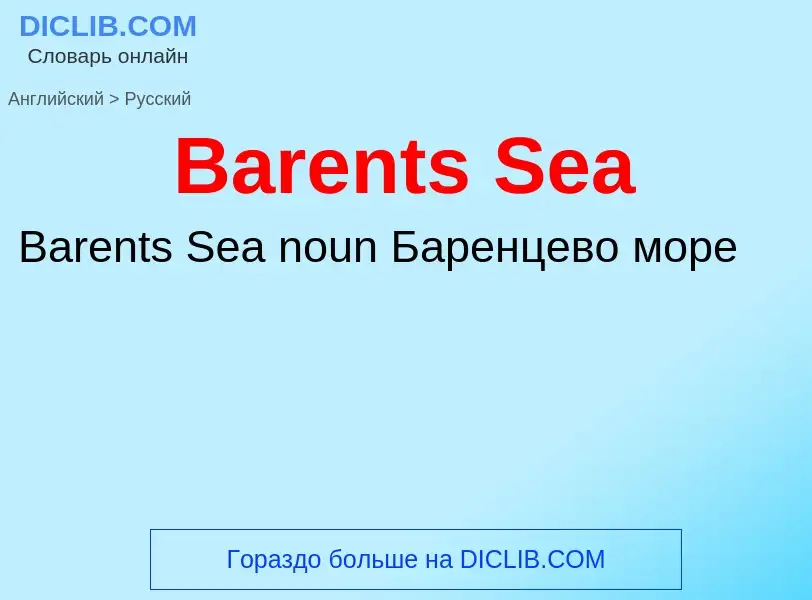Tradução e análise de palavras por inteligência artificial ChatGPT
Nesta página você pode obter uma análise detalhada de uma palavra ou frase, produzida usando a melhor tecnologia de inteligência artificial até o momento:
- como a palavra é usada
- frequência de uso
- é usado com mais frequência na fala oral ou escrita
- opções de tradução de palavras
- exemplos de uso (várias frases com tradução)
- etimologia
Barents Sea - tradução para Inglês
['bærənts'si:]
география
Баренцево море
существительное
общая лексика
Баренцево море
Definição
2) Эгейское море
Wikipédia

The Barents Sea ( BARR-ənts, also US: BAR-ənts; Norwegian: Barentshavet, Urban East Norwegian: [ˈbɑ̀ːrn̩tsˌhɑːvə]; Russian: Баренцево море, romanized: Barentsevo More) is a marginal sea of the Arctic Ocean, located off the northern coasts of Norway and Russia and divided between Norwegian and Russian territorial waters. It was known among Russians in the Middle Ages as the Murman Sea ("Norse Sea"); the current name of the sea is after the historical Dutch navigator Willem Barentsz.
The Barents Sea is a rather shallow shelf sea, with an average depth of 230 metres (750 ft), and it is an important site for both fishing and hydrocarbon exploration. It is bordered by the Kola Peninsula to the south, the shelf edge towards the Norwegian Sea to the west, and the archipelagos of Svalbard to the northwest, Franz Josef Land to the northeast and Novaya Zemlya to the east. The islands of Novaya Zemlya, an extension of the northern end of the Ural Mountains, separate the Barents Sea from the Kara Sea.
Although part of the Arctic Ocean, the Barents Sea has been characterised as "turning into the Atlantic" or in process of being "Atlantified" because of its status as "the Arctic warming hot spot." Hydrologic changes due to global warming have led to a reduction in sea ice and in stratification of the water column, which could produce major changes in weather in Eurasia. One prediction is that as the Barents Sea's permanent ice-free area grows additional evaporation will increase winter snowfalls in much of continental Europe.


![[[Honningsvåg]] is the most northerly fishing village in Norway [[Honningsvåg]] is the most northerly fishing village in Norway](https://commons.wikimedia.org/wiki/Special:FilePath/Honningsvåg 2013 06 09 3495 (10319135545).jpg?width=200)
![The harbour of the [[Murmansk Fjord]]. The harbour of the [[Murmansk Fjord]].](https://commons.wikimedia.org/wiki/Special:FilePath/MurmanskHarbour.jpg?width=200)

![Dutch whalers near [[Svalbard]], 1690 Dutch whalers near [[Svalbard]], 1690](https://commons.wikimedia.org/wiki/Special:FilePath/Walvisvangst bij de kust van Spitsbergen - Dutch whalers near Spitsbergen (Abraham Storck, 1690).jpg?width=200)






![[[Erythraean Sea]] 1838. [[Erythraean Sea]] 1838.](https://commons.wikimedia.org/wiki/Special:FilePath/Soulier, E.; Andriveau-Goujon, J. Anciens Empires Jusqua Alexandre. 1838.jpg?width=200)
![Jansson]] Map of the Indian Ocean ([[Erythraean Sea]]) Jansson]] Map of the Indian Ocean ([[Erythraean Sea]])](https://commons.wikimedia.org/wiki/Special:FilePath/1658 Jansson Map of the Indian Ocean (Erythrean Sea) in Antiquity - Geographicus - ErythraeanSea-jansson-1658.jpg?width=200)

![17th century map depicting the locations of the ''[[Periplus of the Erythraean Sea]]'' 17th century map depicting the locations of the ''[[Periplus of the Erythraean Sea]]''](https://commons.wikimedia.org/wiki/Special:FilePath/PeriplusAncientMap.jpg?width=200)
![A horizontal Malabar Coast miniature, a reprint by [[Petrus Bertius]], 1630 A horizontal Malabar Coast miniature, a reprint by [[Petrus Bertius]], 1630](https://commons.wikimedia.org/wiki/Special:FilePath/A horizontal Malabar Coast miniature, a reprint by Petrus Bertius, 1630.jpg?width=200)
![Asia. [[Sinus Persicus]] and the Mare Persicum Asia. [[Sinus Persicus]] and the Mare Persicum](https://commons.wikimedia.org/wiki/Special:FilePath/Asia in the shape of the mythical winged horse Pegasus..jpg?width=200)
![Iran and [[Makran]] Iran and [[Makran]]](https://commons.wikimedia.org/wiki/Special:FilePath/Map of persia.jpg?width=200)


![Palm]] and [[sunset]] in [[Minoo Island]], Iran. Palm]] and [[sunset]] in [[Minoo Island]], Iran.](https://commons.wikimedia.org/wiki/Special:FilePath/Nakhl-Minoo.jpg?width=200)
![[[Dugong]] mother and her offspring in shallow waters. [[Dugong]] mother and her offspring in shallow waters.](https://commons.wikimedia.org/wiki/Special:FilePath/Dugong.jpg?width=200)




